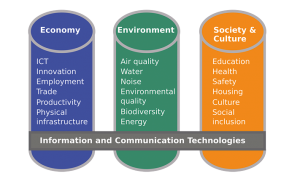

Today, 75% of European citizens live in cities. This percentage is expected to grow to 80% by 2050. Cities consume about two thirds of the world’s energy and are responsible for more than 70% of global man-made CO2 emissions. Thus, cities play a crucial role for reaching the European Union’s CO2 reduction goals and the UN sustainability goals. Information and communication technologies are of key importance for enabling cities to become sustainable. The concept for ICT-enabled sustainability on municipal level is called “smart sustainable cities”.
Definition and origin
According to the definition by the United Nations Economic Commission for Europe (UNECE), “A smart sustainable city is an innovative city that uses information and communication technologies (ICTs) and other means to improve quality of life, efficiency of urban operation and services, and competitiveness, while ensuring that it meets the needs of present and future generations with respect to economic, social, environmental as well as cultural aspects.”
The roots of the smart cities concept go back to the “cybernetically planned cities” of the 1960s and proposals for networked cities in urban development plans from the 1980s onwards. In the late 1990s the “smart growth” movement emerged, which prepared the ground for the concept of smart cities. The smart cities concept became popular within the first decade of this millennium. It was less about developing new technologies, but rather about interconnecting and synchronising existing technologies, products and services within the networked system called city.
However, this focus on technology and the efficiency gains through ICT limited the smart city concept and its usefulness for achieving environmental and social sustainability goals. Thus, the concept was expanded to smart sustainable cities.
In 2015, the International Telecommunication Union (ITU) established a Study Group, SG20, on “Internet of things (IoT) and smart cities and communities (SC&C)”. SG20 defined a set of smart sustainable cities indicators for measuring the progress of cities towards becoming smart and sustainable. These indicators cover the economic, environmental, and social dimensions of sustainability (see figure).
In 2016, the United Nations launched the initiative “United 4 smart sustainable cities” (U4SSC), which is coordinated by ITU, UNECE, and the United Nations Human Settlements Programme (UN-Habitat). U4SSC is supported by 13 UN agencies and programmes. It aims to help achieve UN Sustainable Development Goal 11: “Make cities and human settlements inclusive, safe, resilient and sustainable”.

UNECE-ITU smart sustainable cities indicators (2015)
European activities for smart sustainability
The European Union is very active in supporting the movement of cities in the Member States to becoming smart and sustainable. There are, for example, 17 Lighthouse projects with a total of 46 lighthouse cities and 70 fellow cities, which are funded by the European Commission under Horizon 2020. Numerous other Horizon 2020 projects are in one way or another contributing to research and development on solutions for smart sustainable cities. A major push in this area can be expected from the EC’s current Green Deal call under Horizon 2020, which includes the dedicated call topic “Towards Climate-Neutral and Socially Innovative Cities“. All funded activities under the Green Deal call aim to lower CO2 emissions to 55{b28ae05319d94bff0b4d65c5a9f4524dd588360f05c61ef440e1608e0a1c4144} by 2030, compared to 1990 emission levels, and to zero by 2050. At the same time the Green Deal aims to shape the transition to sustainability in an inclusive way.
Beyond the EC’s Horizon 2020, there are smart sustainable city projects funded on EU level by two Knowledge and Innovation Communities (KICs) of the European Institute of Innovation & Technology (EIT), which is an independent EU body. These two KICs are the EIT Climate-KIC and EIT InnoEnergy, the latter with a focus on sustainable energy innovations.
On the financial side, it is important to mention the European Investment Bank (EIB), the financial arm of the European Union. The EIB supports a broad range of urban projects in areas like energy, mobility, buildings, water, and social infrastructure.
In addition to the EU, there are a number of further European organisations and initiatives active in the area of smart sustainable cities. Some of the most prominent include: ICLEI Europe, the European branch of Local Governments for Sustainability; Eurocities, a Europe-wide network for the development of cities; Energy Cities, The European association of cities in energy transition; and the Covenant of Mayors for Climate & Energy Europe. They represent the bottom-up initiatives of many European cities acting on their commitments to become climate-neutral through reduction of CO2 emissions as well as reconcile this with sustainable economic and social development that includes all citizens.
European cities and the European Commission work together in activities like the recent Green City Accord, an initiative to make cities greener, cleaner and healthier, which was launched during the European Week of Regions and Cities in October 2020. The Green City Accord is a movement of European mayors which aims to improve the quality of life of all Europeans, and accelerate the implementation of relevant EU environmental laws. By signing the Accord, cities commit to addressing five areas of environmental management: air, water, nature and biodiversity, circular economy and waste, and noise.
West-East divide in Europe
All these initiatives and the funding gone into them have led to substantial achievements on the path to smart sustainability. However, the current situation in Europe is still divided: while there are a number of cities in Western Europe which have progressed already quite well, the situation especially in Eastern Europe is not as rosy yet.
According to the Lisbon ranking of 28 European capital cities, which was published in 2019, there is a striking geographic divide: 12 of the top 14 cities in the ranking are Western European; 11 of the bottom 14 cities are Eastern European. The ranking is based on 32 indicators, which are related to environmental, social, and economic aspects. Other rankings based on different criteria come to different results for individual cities but confirm the overall impression of a divide between European cities – those that have already progressed well on the path to smart sustainability and those that still have a long way to go.
Major smart city technologies
The technologies that induce “smartness” into cities can be broadly categorised into Internet of Things (IoT), Big Data and ICTs that provide the technical frameworks to implement smart sustainable cities. The “things” of the IoT – devices, sensors, applications – collect the data that facilitate the technology solutions. Although still at a fraction of the possibilities, the current instalment base of sensors and devices is already huge, which leads to an enormous amount of data that has to be collected, analysed and processed in order to extract relevant knowledge that is used by dedicated applications for doing their job. The applications are numerous and include tasks like optimisation of city utilities, such as energy, water and waste, optimisation of traffic for passengers and goods, and efficient public protection measures.
Such smart city applications are inherently data-driven, which is why Big Data analytics play an important role in overall city management. Over the last years several solutions, called platforms, have been deployed for managing the process, which are not always easily interoperable. Standards bodies have worked for a number of years on creating the necessary standards to leverage the economies of scale. The International Standards Organisation (ISO) has recently published a short overview of which standards are necessary in the different areas relevant for a smart sustainable city. The complexity of the problem is highlighted by the use of words like “overarching frameworks”, “foundations and platforms”, which are used in the ISO publication.
5G connectivity is currently being introduced as the backbone of smart city technologies. 5G networks provide urban areas with the necessary infrastructure to connect myriads of devices and sensors, enabling the IoT to work efficiently. Advanced information and communication technologies enable unprecedented capabilities for monitoring smart city parameters, for example by using unmanned aerial vehicles. ICTs also enable efficient urban planning by using accurate geo-location data that can be obtained from high-altitude platforms and Earth observation satellites.
Key role of citizens
Beyond ICT, an essential part of any city and any action towards achieving sustainable cities is the citizen. The actions that will be put in place must be accepted and supported by the citizens. A substantial shift has to be induced in the behaviour of citizens, in order to achieve sustainability goals in cities. Recent research in social sciences indicates that the involvement of citizens in a co-creation process for the implementation of the actions is a promising way for achieving sustainability goals. Nonetheless, it is still not well researched how to measure the citizens’ behavioural change and how to correlate this change to the technically measurable parameters of utilities management, environmental conditions, energy consumption or mobility patterns.
Outlook
Despite the plethora of organisations, initiatives and projects working on making cities smart and sustainable through the use of advanced ICTs like IoT, Big Data, and more, the challenge is still enormous. In order to get the majority of cities in Europe onto the path to smart sustainability and achieve zero CO2 emissions by 2050, current efforts need to be increased and better synchronised. Plans to do this are under way. Future will tell to what extent these plans can be implemented across European cities with wide differences in development.
Further information
- ITU SG20: Internet of things (IoT) and smart cities and communities (SC&C) – https://www.itu.int/en/ITU-T/studygroups/2017-2020/20/Pages/default.aspx
- United 4 smart sustainable cities initiative – https://www.itu.int/en/ITU-T/ssc/united/Pages/U4SSC-info.aspx
- smart cities and Communities Lighthouse projects – https://smartcities-infosystem.eu/scc-lighthouse-projects
- EIT Climate-KIC – https://www.climate-kic.org
- EIT InnoEnergy – https://www.innoenergy.com
- Energy Cities – https://energy-cities.eu/
- ICLEI – https://iclei-europe.org/
- Eurocities – https://eurocities.eu/
- Covenant of Mayors for Climate & Energy Europe – https://www.covenantofmayors.eu/
- ISO and sustainable cities (brochure, April 2020) – https://www.iso.org/files/live/sites/isoorg/files/store/en/PUB100423.pdf